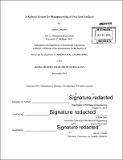| dc.contributor.advisor | A. John Hart. | en_US |
| dc.contributor.author | Stevens, Adam Gregory | en_US |
| dc.contributor.other | Massachusetts Institute of Technology. Department of Mechanical Engineering. | en_US |
| dc.date.accessioned | 2016-03-03T21:04:07Z | |
| dc.date.available | 2016-03-03T21:04:07Z | |
| dc.date.copyright | 2015 | en_US |
| dc.date.issued | 2015 | en_US |
| dc.identifier.uri | http://hdl.handle.net/1721.1/101485 | |
| dc.description | Thesis: S.M., Massachusetts Institute of Technology, Department of Mechanical Engineering, 2015. | en_US |
| dc.description | Cataloged from PDF version of thesis. | en_US |
| dc.description | Includes bibliographical references (pages 79-88). | en_US |
| dc.description.abstract | Additive manufacturing by photopolymerization (e.g., stereolithography) is attractive due to its high resolution and its compatibility with soft and hard polymers, composites, and biomaterials. While traditional stereolithography machines are designed to build on planar substrates, patterning of non-planar surfaces would enable integration of new functionality onto existing objects for applications such as structurally integrated sensors, conformal electronics, and customized medical implants. This thesis presents the design, construction, and initial performance evaluation of a robotic system capable of maskless photopatterning on objects having complex curvature and dimensions ranging from centimeters to meters. The system incorporates a six-axis serial robot arm, a high-precision rotary stage, a custom-built DLPbased end effector, and custom software that coordinates and controls the system. The workpiece is patterned by first digitally triangulating the surface with a 3D scanner and associating the location of each triangle in the digital space with the corresponding location on the workpiece surface in real space. Subsequently, the area enclosed by each triangle is associated with a user-specified texture photomask. The large-area photopattern is then fabricated by sequentially exposing each individual textured triangle in the photomask as the robot steps to each corresponding location on the workpiece surface, which is coated with a photocurable polymer. By measuring patterning results on a test object, the system was determined to have a positioning accuracy over a subsection of the working volume of 330tm and a repeatability of 20pm was measured by a motion test. The system positioning accuracy is limited by performance of the actuators and the kinematics of the manipulator. System patterning rate is limited by the power output of the light source. The system's performance is demonstrated by patterning a 21cm diameter sphere with a map of the Earth and performing a preliminary test on the patellar surface of an anatomical femur model. Future work will focus on improving the system accuracy by mapping the workspace using a coordinate measuring machine and increasing throughput by a combination of increased optical power and more efficient use of the projection field of view. The system will also be investigated as an enabling technology for deterministically patterning cartilage cells onto joint surfaces or three-dimensional anatomical models. | en_US |
| dc.description.statementofresponsibility | by Adam G. Stevens. | en_US |
| dc.format.extent | 88 pages | en_US |
| dc.language.iso | eng | en_US |
| dc.publisher | Massachusetts Institute of Technology | en_US |
| dc.rights | M.I.T. theses are protected by copyright. They may be viewed from this source for any purpose, but reproduction or distribution in any format is prohibited without written permission. See provided URL for inquiries about permission. | en_US |
| dc.rights.uri | http://dspace.mit.edu/handle/1721.1/7582 | en_US |
| dc.subject | Mechanical Engineering. | en_US |
| dc.title | A robotic system for photopatteming of freeform surfaces | en_US |
| dc.type | Thesis | en_US |
| dc.description.degree | S.M. | en_US |
| dc.contributor.department | Massachusetts Institute of Technology. Department of Mechanical Engineering | |
| dc.identifier.oclc | 938932136 | en_US |
